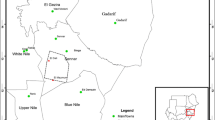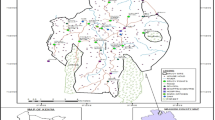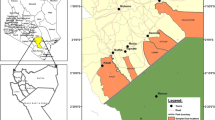Abstract
Homegardens of Bukoba are a traditional multi-storey agroforestry farming system based on mixed cropping and livestock keeping. Major crops are banana (Musa spp.) grown for food and coffee (Coffea canephora var.robusta) for cash. Livestock keeping is dominated by cattle. Over the last few decades the farming system in Bukoba has been pervaded by a host of constraints ranging from biological to socio-economic. Consequently farm productivity has declined and so has the economic welfare of the people in the area. A questionnaire survey was conducted in 1991 to 72 households in Bukoba district to compare three potential farming systems: the rehabilitation of the homegardens, the cultivation of two annual crops namely maize and beans as intercrops and the continuation of the current non-rehabilitated homegardens. Results strongly support the rehabilitation of homegardens by use of cattle manure and proper crop and livestock husbandry practices. Rehabilitated homegarden has the highest net present value and is not very sensitive to changes in prices of inputs and outputs.
Similar content being viewed by others
References
Ackland JD (1971) East African Crops. Longman, London
Bank of Tanzania (1991) Economic Bulletin for the Quarter Ended 31st March, 1991. Vol 1. Tanzania Printers Limited, Dar-es-Salaam
Cory H (1957) Historia ya Wilaya ya Bukoba (History of Bukoba District). Lake Printing Works Ltd, Mwanza, Tanzania
Friedrich KH (1968) Coffee-banana holdings at Bukoba: the reasons for stagnation at a higher lever. In: Ruthenberg H (ed) Smallholder Farming and Smallholder Development in Tanzania, Ten Case Studies, pp 175–212. IFO Afrika-Studien. Munich
Koninklijk Instituut voor de Tropen (1989) Diagnostic survey of Bukoba district. Working paper #3. Amsterdam
Lipsey RG, Steiner PO, Purvis DD and Courant PN (1990) Economics. Harper & Row, New York
Mkamba I (1986) Maruku Agricultural Research Institute. Annual Reports 1981–86. Bukoba, Tanzania
Rugalema GH (1992) Homegardens of Bukoba: description, critical constraints and farm economic analysis of possible solutions to falling productivity. Unpublished MSc thesis, Agricultural University of Norway, Ås
Rugalema GH, Okting'ati A and Johnsen FH (1994a) The homegarden agroforestry system of Bukoba district, North-Western Tanzania. 1. Farming system analysis. Agroforestry Systems 26(1): 53–64
Rugalema GH, Johnsen FH and Rugambisa J (1994b) The homegarden agroforestry system of Bukoba district, North-Western Tanzania. 2. Constraints to farm productivity. Agroforestry Systems 26(3): 205–214
Samki JK and Harrop JF (1984) Fertilizer recommendations in Tanzania on a district by district basis. National Soil Service, Tanga
Tibaijuka AK (1984) An analysis of smallholder banana-coffee farms of Kagera Region, Tanzania: causes of decline in productivity and strategies for revitalization. Published PhD thesis. Swedish University of Agricultural Sciences, Uppsala
Author information
Authors and Affiliations
Rights and permissions
About this article
Cite this article
Rugalema, G.H., Johnsen, F.H., Okting'ati, A. et al. The homegarden agroforestry system of Bukoba district, North-Western Tanzania. 3. An economic appraisal of possible solutions to falling productivity. Agroforest Syst 28, 227–236 (1994). https://doi.org/10.1007/BF00704758
Issue Date:
DOI: https://doi.org/10.1007/BF00704758




